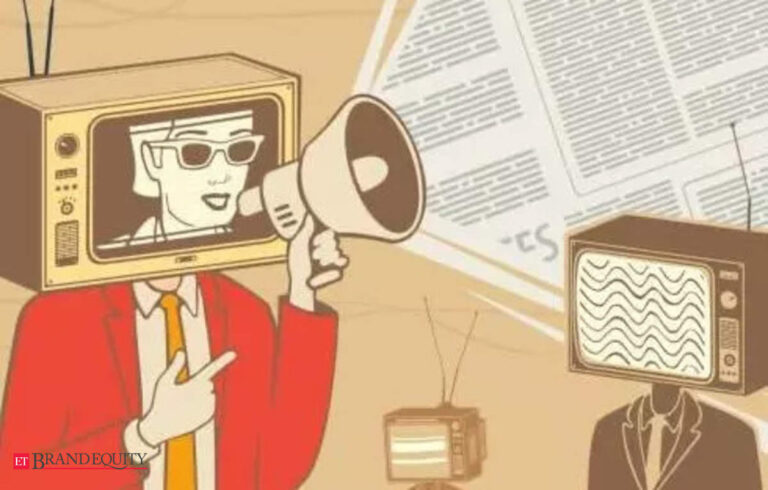 (Representative image)
(Representative image)While the CRT may still be a prized possession and at the heart of most homes, it has lost its centrality to everyday life in terms of the most precious thing in the media world: ownership of the story. The drop in viewership from the start of the election to its end has brought this back into the spotlight.
News has been a booming genre over the past five years. Naturally, millions of voters were expected to be glued to their television screens from the announcement of elections to voting and especially on vote counting day. However, data from the recent Indian Lok Sabha elections suggests that this is not the case.
In India’s urban markets, the top three Hindi news channels saw a drop in viewership of as much as 85 percent. At the HSM level, a drop of 16 percent was observed, with AajTak and India TV seeing significant declines in viewership, while Network 18 and TV9 Bharatvarsh saw increases in viewership.
Some channels did not report properly in 2019, so figures for other channels are not comparable.
However, one important point has emerged: it is no longer the monopoly of a few major channels like Aajtak and Zee News. The emergence of alternative options like News18 and TV9 has given both viewers and advertisers more options to reach a wider audience.
It would be instructive to explore the factors behind these changes in viewing patterns.
Before diving into the analysis, however, I would like to elaborate on the development of television and digital media itself.
Media is entertainment with a beginning, middle and end. It is the main force behind the growth of television viewership. Then there is news and sports. Many would argue that stories are a diversion or an escape, while news is a necessity that people crave. At a societal level, raised on a controlled diet of Doordarshan, the growth of private media was considered a good thing to increase exposure to the truth and support the public interest.
Then, news reporting succumbed to commercialism and the news modus operandi changed completely, from a rigorous journalism culture of literalist nature and persuasive investigative journalism to mere opinions expressed with vociferous supporting commentary.
Political news took over the news, with the usual shouting contests between various “spokesmen” and news anchors on the floor. In the midst of all the noise and din, confusion was the only thing that stood out.
Meanwhile, as the volume of news exploded, hundreds of channels began broadcasting. This was a cheaper way to enter the industry; it didn’t require reliance on special talent and everyone had equal access to hit shows. The proliferation of TV news platforms was not unique to India. The rise of CNN and Fox came to the US, as did Sky and similar programmes, which oscillated between conservative and liberal wings in Berlusconi’s Italy and other European countries.
There has been a fundamental shift from news to stories, between the moral imperative to tell the truth and raise questions, and the urgent need to tell stories and capture public attention.
Digital media had fallen prey to the idea that information was currency and algorithms were the arbiters of choice. New media could deliver information faster, cheaper and more personalized.
Digital media was a great fit for news, not just because of its speed, but because it was all about future revenue. When digital media started, there was no revenue at all. The cheaper the better.
Digital news is a kind of information arbitrage: how cheaply can you get it, and what percentage of the premium will advertisers pay? Count the number of live phones with digital access and you’ll see the answer.
The news genre is naturally suited to digital consumption. News is an instantaneous reality. News is time-sensitive information, a complex and fragile value proposition. First, its value degrades rapidly, within seconds. The next day, a report that the last man standing is no longer valuable. Everyone wants instantaneous information.
Where is the original content, and certainly not the actually good or well-crafted content? As all this has happened, the demographics have changed. Around 400 million people in India are under the age of 20, and this is the only reality they have ever faced. It’s no surprise that there is a wealth of choice.
It also forces TV to be more selective in its programming. But common information is not news; its value is determined by its scarcity. What everyone knows is not news. If news is available everywhere, repeating it is not a useful or valuable job. So while YouTube influencers, experts, and advocates (call them what you will) bring the scoop and gossip, TV reporters are becoming more and more monochromatic.
Television squandered that quality. Its long history of credibility, unique authority, clear personality, sophistication, and distinctiveness that is hard to establish overnight were deemed a weak profit driver. It relied on loud drama and deliberate crises. Exaggerating small issues became its crown jewel.
A sensible assessment would say this approach is a risky business proposition, because the news does not create value in itself, but depends on the context that surrounds it.
But here it is: Naturally, the urge to resist, to skim over, or to become distracted is born.
Did that happen in the assessment of the 2024 election?
Has digital captured your attention?
Did people exist in finite populations in their own echo chambers?
Has television failed to grow the audience for political news?
I may write about this another time, but we need to distinguish between television as content and television as a medium, a channel, a method of delivery. The problems lie in both.
Some key factors I think are:
Fragmentation
Compared to the 2019 general election, the COVID pandemic has dramatically changed content consumption patterns. Digital platforms have become more prominent and fragmented. As audiences have become more mobile, TV is no longer the primary medium for getting information, leading to a decline in consumption and viewership. People browse on the go. The digital or YouTube window on the same TV platform has expanded.
Longer Periods
The time between voting and being sworn in was long. The entire election process, from the first vote on April 19 to the counting of votes on June 4, lasted 50 days, with multiple states casting ballots in one or all of the seven phases. This long period led to audience fatigue with election news. The cumulative viewership that usually builds momentum was lacking this time. Regional content was on the rise on both TV and digital, and language-island markets were not influenced by what was happening in other states or across the nation for traction.
Multiple Platforms
A major change observed is the trend towards consuming content on multiple screens. The rise of connected TVs has allowed digital content to be viewed on larger screens. Political debates, traditionally a personal experience, are finding new audiences on personal screens, leading to a decline in TV ratings. It also raises questions about the demand for national, regional, local and micro news. Digital offers a full range of information, cheaper and more immediate than TV.
Election Results
Election day traditionally sees record ratings, but this election did not favor any particular party, leaving viewers looking for an alternative explanation. The lack of clarity about the final outcome also contributed to the decline in viewership.
Advertiser’s perspective
Advertisers had high expectations based on benchmarks from the last election. Although this election was one of the most-watched news events, the overall drop in viewership highlighted the possibility that advertisers who had invested heavily in sponsorships and other promotions did not see significant returns. Maintaining a consistent presence on the channel may have been a more effective strategy for advertisers.
So, has television lost its footing completely, or is this further evidence that algorithms don’t just create tidy worlds of information, but ones that are deeply personally engaging, where information becomes highly curated, contextualized, even dramatic, experiences?
In the future we will know.
Check out the news!



